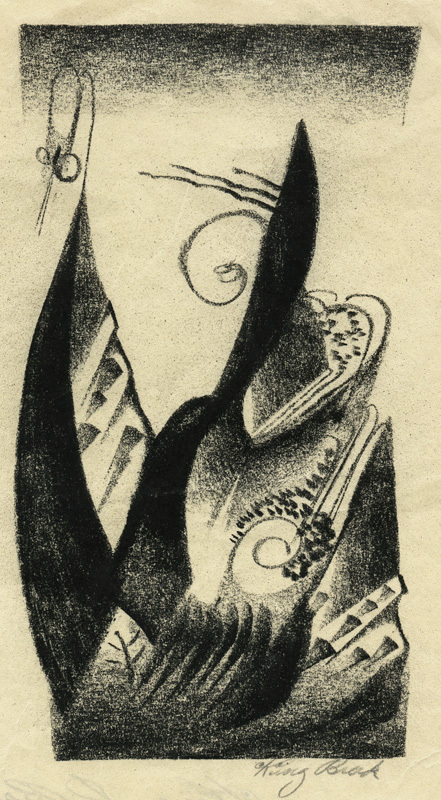
19th, 20th & 21st Century Fine Prints
707-546-7352 · fax 707-546-7924 · web: www.annexgalleries.com · email: artannex@aol.com
Untitled abstraction by Kingsley Dawson Brock

Untitled abstraction
Kingsley Dawson Brock
Untitled abstraction
Kingsley Dawson Brock
1912 - 1995 (biography)Kingsley "King" Dawson Brock was the first Black American artist to be given an exhibition at the Pasadena Junior College (1935), he worked with the WPA in Los Angeles in the late 1930s, and participated in the first Rose Bowl Art Exhibition in 1971.
In this untitled work the viewer can detect the hallmarks of early American Abstract Expressionism, fresh off the heels of the European Surrealist movement. Unusual plant-like forms are presented in a jazzy, cerebral style. This interest in high contrast modernism would carry over into Brock's later figurative works. A rare and interesting piece of American Abstract Expressionist art history that remains shrouded in mystery.
King Brock was born in Pasadena, California on 3 February 1912 to William W. and Rhoda Ann Dawson Brock. He attended the Grover Cleveland Elementary School, the John Muir Technical High School, the Pasadena Junior College, and the Stickney Art School. Brock found employment on the WPA Federal Art project in Southern California and became a teacher in the program. When Brock registered for the draft on 16 October 1940, he was working for the Baruch Corporation, one of the largest general contractors in Southern California. Later Brock worked as an illustrator for the Fort MacArthur Newspaper in San Pedro, California during WWII. He enlisted in February 1945 and, upon his return to civilian life, he worked as a carpenter to support his family but continued creating art.
During the years 1952-1958 and 1967, King Brock was a featured artist in the Women's Sunday Morning Breakfast Club's Cinderella International Souvenir Book. The WSMBC, an organization founded by Theresa Lindsay, sought to help the poor, educate the youth, honor the aged, and contribute to the agencies that helped the disenfranchised. Many of Brock's drawings were seen as a result of the WSMBC's support, and a series of paintings entitled the New Breed received critical acclaim after gracing the cover of the group's annual commemorative book.
A member of the Pasadena Society of Artists for more than forty-five years, King Brock's work was featured in Ebony and Jet magazines and he was involved with the Brockman Gallery in Los Angeles' Leimert Park neighborhood, which was the first major gallery run by and for Black artists.
During Richard Candida Smith's January 1990 interview with John W. Outterbridge at his Watts Towers, Outterbridge recalled Kingsley Brock: "There was a man in Pasadena who's still living. I see him walking about every now and then. I don't think he's doing art anymore. His name was King Brock. "King Brock," that's what we used to call him. We used to take King Brock and the man that you are talking about- They were just kind of giants from the past that really were not giants that everybody knew about. They weren't as well-known as you thought they should have been. Because Brock was a man who thought too fast, and he spoke just like he thought. Just like his thoughts came, he spoke, very rapidly, you know. He used to come to affairs in the parks, outdoor exhibits, with a big roll of white paper—a roll about two feet wide, the kind of thing that you could just pull out and make sketches on. Whatever he saw, whatever the conversation was about, whatever ideas he had flowing through his mind, that's what he'd just sketch out in charcoal. People would become fascinated with those sketches. He'd simply tear it off and let them have it. Whatever they'd give him for it, he'd take that, then roll it out again. He'd just keep sketching and sketching and sketching."
